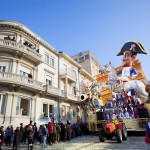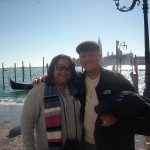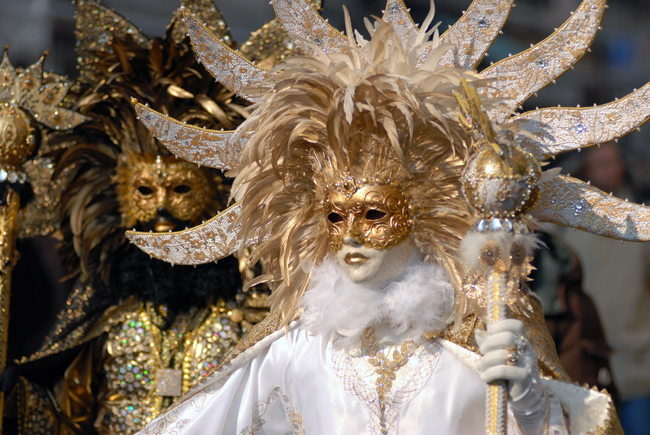
After the Christmas and New Year celebrations, the country of Italy’s next big party during the winter season would be the world-famous Carnevale, or Carnival. It is traditionally held as a final chance to have fun before the more somber Lenten season arrives, and it is also a goodbye to the cold months as people begin looking forward to spring.
Though we often associate the Carnevale with just Venice, many cities and towns all over the country actually celebrate this holiday, each with their own unique twists and highlights. However, the biggest and most elaborate parties are at Venice, Viareggio, and Cento, so if you would like to join a bigger crowd, head to these cities. Some of the most popular Carnevale destinations are the following:
Venice
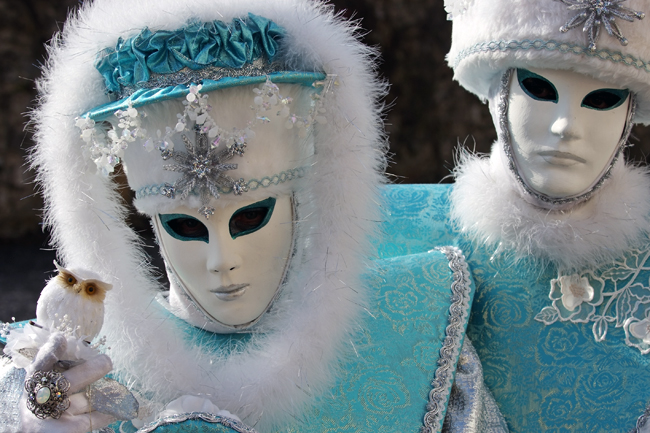
In the City of Bridges, the festivities tend to begin up to two weeks before the official date of the Carnevale. In the days leading up to that day, there are various events and forms of entertainment that are scattered throughout the city and held nightly. During this period, seeing people wandering around in costume will be a common sight. A few of the Venetian highlights include gondola and boat parades on the Grand Canal, masquerades and costume contests at Piazza San Marco, as well as a mini-Carnevale for children. On the evening of Shrove Tuesday, there will be a grand fireworks show to mark the end of the celebration.
(Tip: This year’s Venetian Carnival will be especially grand as it is being held in association with the World Expo which will be held in Milan later this year!)
Viareggio
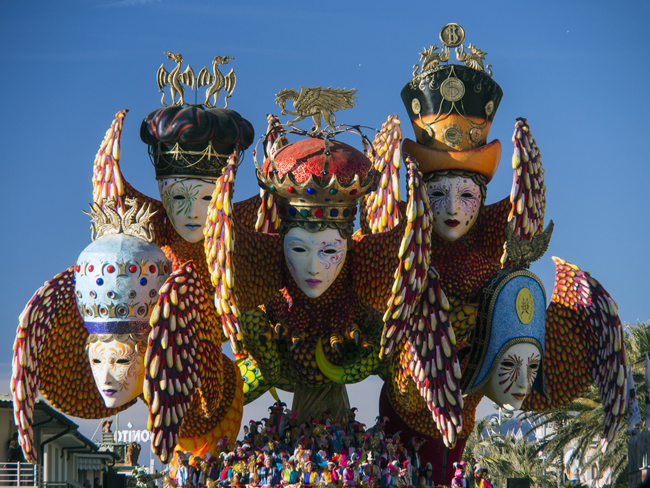
Over at Tuscany, Viareggio is known to have one of the biggest Carnevale celebrations in Italy. One of its most distinguishing traits would be its giant, allegorical paper maché floats that show up during parades, and can be seen around the city up to three Sundays before Shrove Tuesday, and up to two weekends after. Take note however, that there is an admission charge to view the parades. As in Venice, there will also be various, cultural and musical events, as well as masked balls take place throughout the Carnevale season, and restaurants tend to have special holiday menus available. You can also visit the Cittadella del Carnevale di Viareggio (Carnival Museum) that is open on weekend afternoons.
Ivrea
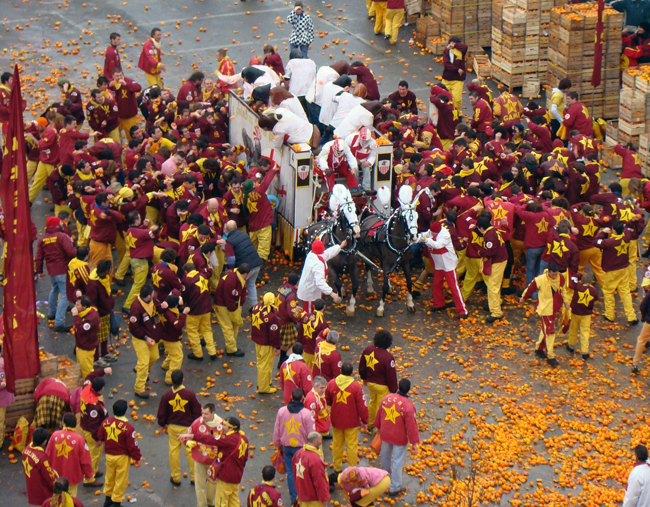
Up north in Piedmont, the Carnevale takes on a unique, citrusy twist. The holiday season begins about a month or so prior to the actual day of the Carnevale, and a colorful parade takes place around the whole town. Afterwards, during the weekend of the holiday itself, everyone gathers at the main square, and everything culminates into what is known as “The Battle of the Oranges”, where people, as the name suggests, throw oranges at each other. It is also known as Italy’s largest food fight.
During the time leading to the main event, there are various events and exhibits that depict the origins of their version of the festival. The story goes that during 12th or 13th century, a tyrannical local duke attempted to rape a miller’s daughter on her wedding night by exerting his supposed right as the local leader to take the virginity of newlyweds under his jurisdiction. In defiance, the bride who was named Violetta, 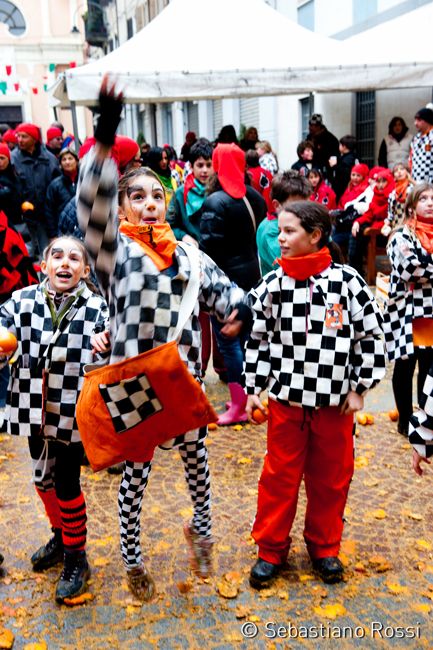 resisted this act and decapitated him. Afterwards, the townspeople stormed, burned, and demolished the duke’s palace. The oranges in the present-day celebrations/battle are meant to represent ancient weapons and stones that were used to bring down the tyrant’s residence.
resisted this act and decapitated him. Afterwards, the townspeople stormed, burned, and demolished the duke’s palace. The oranges in the present-day celebrations/battle are meant to represent ancient weapons and stones that were used to bring down the tyrant’s residence.
In commemoration of this legend, every year, one of the local girls is elected to play the part of Violetta. Meanwhile, a “general” is also assigned, and the rest of the battle participants, or “Aranceri” (“orange handlers”) are divided into teams, with some relegated to go on foot while others are chosen to ride in carts. The ones on the ground play the part of the townspeople, while those in the carts represent the duke’s army.
After the battle which lasts a few days, the end of the Ivrea Carnevale is signaled by a large bonfire in the middle of each district’s piazza. It then closes with a “funeral” where the Aranceri solemnly march, while the “general” officially ends the holidays by bidding everyone goodbye in the local dialect, saying “arvedse a giobia a ‘n bot,” which is translated as “we’ll see each other on Thursday at one,” referring to the Thursday the carnival will start the next year.
For travelers who wish to witness this exciting event, take note of the routes which are meant specifically for spectators. These are usually marked by the nets that you can hide behind which are draped around buildings, and these areas are important if you are traveling with children or simply don’t want to get pelted with fruit.
Another important thing to remember would be to wear a red hat known as a Berretto Frigio or Phrygian Cap. Spectators must keep this on AT ALL TIMES as it is a signal for the Aranceri that you are just there to watch, and that they should NOT directly throw oranges at you (and believe us when we say they do not throw those oranges gently…).
For those who choose to get a taste (haha) of the celebrations first hand, just be aware that just about any area outside the designated spectator zones is considered as part of the battlefield, and opting to stay there has its consequences, so be prepared to run and dodge as necessary. At best, if you are wearing the red hat, you will be hit by a stray orange or five that missed or bounced off of its original target. At worst, without your red hat, you become a target and an active participant in the battle, so be ready to find ammunition and throw oranges back.
Oristano, Sardinia
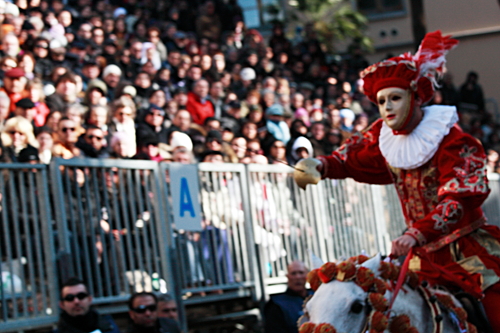
Another unique Carnevale celebration can be found in the city of Oristano on the island of Sardinia. Besides the usual costumes, parades, and various musical and cultural performances, the heart of the celebrations is an event called the Sartiglia which happens over the span of a few days. At this event, costumed and masked horsemen on steeds festooned in flowers and finery participate in a special race. At the finishing line of this race is a small tin star with a hole in the middle that hangs by a ribbon just above the horsemen’s eye level. The participants then gallop towards this star and try to snag it off the ribbon by aiming their swords at the hole. The number of stars that are successfully removed from the ribbon on each day of the Sartiglia is meant to represent the amount of wealth that the next harvest will bring.
At the end of the Sartiglia and the Carnevale, there is an equestrian procession where costumed and masked men and women participate, and this is followed by a show where those same men and women show off their equestrian and acrobatic prowess by performing breathtaking stunts and routines for the spectators.
Acireale, Sicily
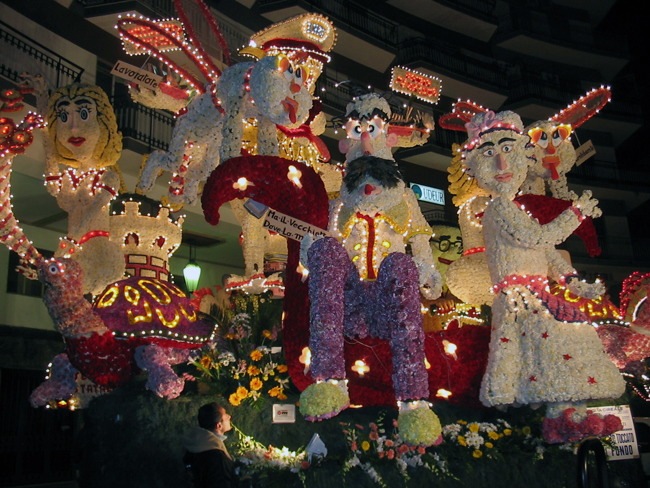
The town of Acireale is known for having one of the most beautiful Carnevale celebrations in Sicily, featuring allegorical floats made of flowers and paper-mache’ which are then paraded through the town’s Baroque center. There are several parades that happen during this time, and of course, there is also music, children’s events, a chess tournament, as well as a fireworks show to cap everything off.
Pont St. Martin, Valel d’Aosta
In the mountainous region of Valle d’Aosta in northwestern Italy, the town of Pont St. Martin celebrates Carnevale in what is literally a Roman style, complete with nymphs and people dressed in togas, as well as chariot races, all with masks on, of course. Known for its first-century Roman bridge which bears the same name as the town itself (or vice versa), local celebrations here are meant to reenact three events and events.
The first is the defeat of the Salassians by the Romans, which is re-enacted by way of chariot races.
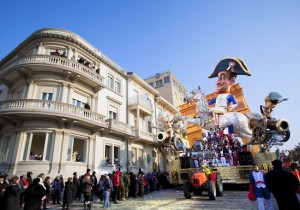 The second is a legend in which the nymph or local deity of the stream that crosses the town was angered by the townspeople, and she decided to swell the banks of her stream in order to flood and destroy the town itself. However, as she and the floodwaters reached the ancient bridge, she was persuaded by the prayers of the townsfolk to slow down and pass under the bridge without causing any damage. Every year, a young local girl is chosen to play the part of the angered nymph, a role which is considered to be prestigious.
The second is a legend in which the nymph or local deity of the stream that crosses the town was angered by the townspeople, and she decided to swell the banks of her stream in order to flood and destroy the town itself. However, as she and the floodwaters reached the ancient bridge, she was persuaded by the prayers of the townsfolk to slow down and pass under the bridge without causing any damage. Every year, a young local girl is chosen to play the part of the angered nymph, a role which is considered to be prestigious.
The third is another legend where Saint Martin, who was also the Bishop of Tours, found himself obstructed by the river on his way back from Italy to his dioceses. He had learned that the river had swept way the only walkway during a recent flood, and that the townspeople were unable to rebuild it because the Devil would destroy anything they constructed. Upon hearing this, St. Martin decided to have a word with the Devil, who agreed to let the locals build the bridge upon the condition that he claims would claim the first soul to cross the bridge once it is completed. St. Martin accepts this deal, and the bridge is completed. The next day, as the Devil eagerly waited at the other end of the bridge, St. Martin tossed a piece of food where the Devil was, and a hungry dog ran after it, making it the first soul to cross the bridge. Furious that he was tricked, the devil disappeared amidst sulfur and bolts of lightning, never to be seen again. This is why on the eve of Shrove Tuesday, the end of the Carnevale festivities is signaled by the hanging and burning of an effigy of the devil on the 2000 year-old bridge.
Cento
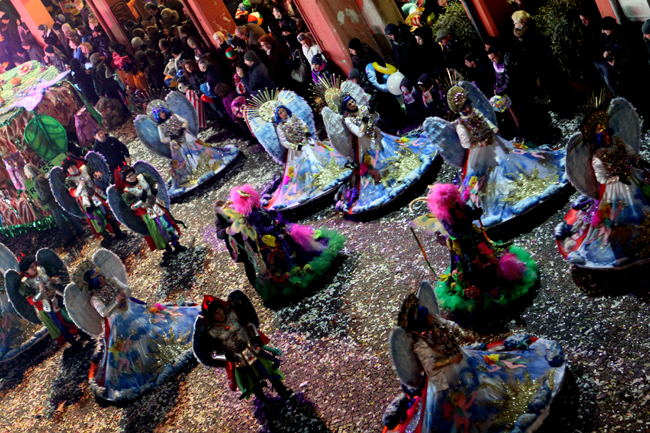
As mentioned previously, one of the largest Carnevale celebrations in Italy is at Cento in the Emilia Romagna region, as it is linked to the most famous Carnival celebration in the world which is the one at Rio de Janeiro in Brazil. The Cento celebrations feature floats of very high quality that often incorporate items, motifs, and themes from Brazil. A float competition is held, and the winning float in the Cento parade is then taken to Brazil to participate in the Brazilian carnaval. At this event, one can easily spot a good number of Italian and international celebrities who 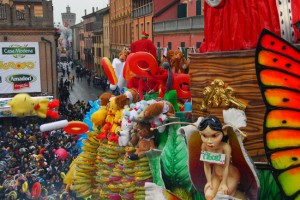 are often seen riding one of the many floats, from which they and other float participant toss candy to the nearby spectators.
are often seen riding one of the many floats, from which they and other float participant toss candy to the nearby spectators.
Verona
A short distance from Venice, Verona also has its own Carnevale celebration that features a huge parade in which about 500 different floats participate. As with the parade in Cento, candy and sweets are also thrown into the cheering crowds.
As mentioned previously, almost every city and town has its own way of celebrating the Carnevale, and the ones mentioned here are but a few examples. Therefore, expect places such as Rome, Milan, Florence, and other major destinations to introduce a slightly different flavor of this merry holiday to you. So wherever you are in Italy, just keep an eye on the calendar, keep your mask within easy reach, and get ready to have fun!




